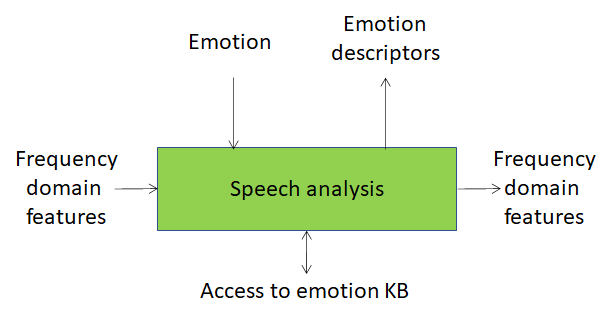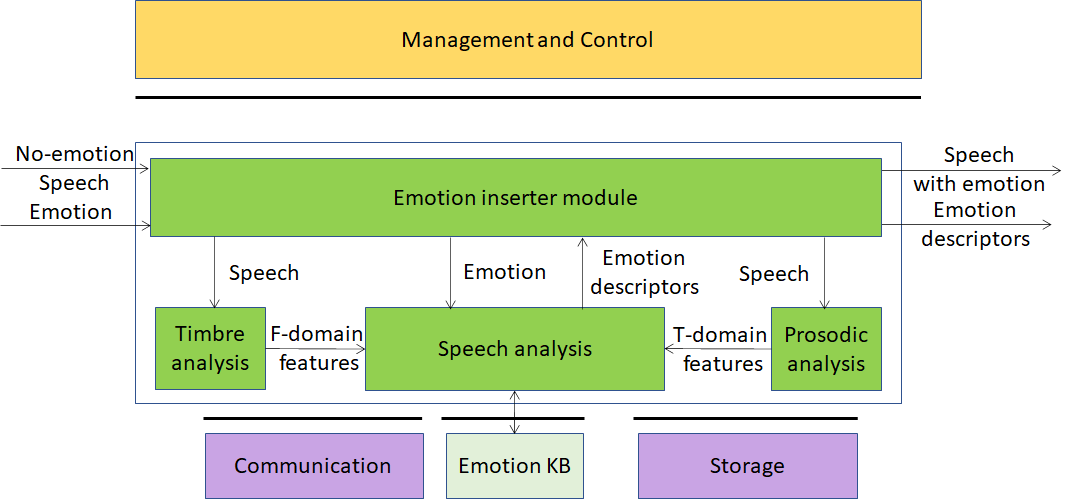Use of technologies based on Artificial Intelligence (AI) is extending to diverse applications yielding one of the fastest-growing markets in the data analysis and service sector. However, AI is developing more slowly than necessary because it lacks operational reference standards comparable to those that have propelled digital media. Moving Picture, Audio and Data Coding by Artificial Intelligence (MPAI) has identified data coding as a promising area for standardisation.
 | MPAI considers the “AI module” (AIM) and its interfaces as the AI building block. The syntax and semantics of interfaces determine what AIMs should perform, not how. AIMs can be implemented in hardware or software, with AI, Machine Learning or legacy Data Processing (DP). |
 | The AIM is part of the MPAI “Emotion Enhanced Speech” Use Case where AI is used to add the desired emotion to an emotion-less speech. The Emotion Knowledge Base (KB) may be absent if the relevant knowledge is moved to a neural network in the Speech analysis AIM. |
So far, MPAI has collected some fifteen Use Cases spanning in the following categories: Context-based Audio Enhancement; Multimodal Conversation; AI-Enhanced Video Coding; Compression and Understanding of Financial Data; Integrative Genomic/Sensor Analysis; and Server-based Predictive Multiplayer Gaming. The first two areas are about to issue Calls for Technologies.
AIMs need a proper environment to enable creation, execution, composition and update of AIM-based workflows. The MPAI-AI Framework (AIF) is the environment for building potentially high-complexity solutions interconnecting multi-vendor AIMs trained for specific tasks and exchanging data encoded in standard formats via standard interfaces.
MPAI has issued a Call for Technologies to develop the MPAI-AIF standard. Called-for technologies should support a set of requirements, including the following:
- ML/legacy DP life cycles (Single AIM)
- instantiate-configure- start-suspend-stop-renove
- dump/retrieve internal state | enforce resource limits
- ML/legacy DP life cycles (Multiple AIMs)
- Initialise | instantiate-remove-configure AIMs
- configure interfaces in manual-automatic-dynamic-adaptive ways
- 1- and 2-way signal for workflow initialisation and control, communication and security policies between AIMs
- Machine learning
- train-retrain-update AIMs
- auto-configure/reconfigure ML-based computational models
- dynamic update of ML models
- support supervised, unsupervised and reinforcement-based learning paradigms
- Workflows
- hierarchical execution of workflows
- computational graphs, such as Direct Acyclic Graph
- AIM topologies synchronised according to time based & full ML life cycles
MPAI is mindful of Intellectual Property Rights (IPR)-related problems accompanying high-tech standardisation. Unlike standards developed by other bodies, which are based on vague and contention-prone Fair, Reasonable and Non-Discriminatory (FRAND) declarations, MPAI standards are based on Framework Licences that set out in advance agreed guidelines for the IPR holders.


